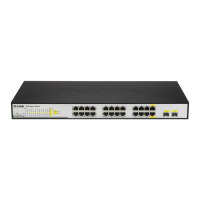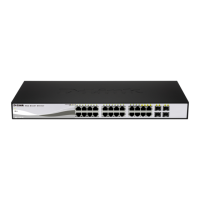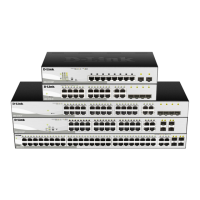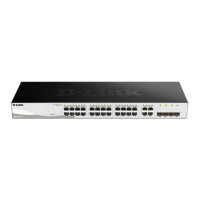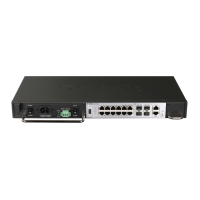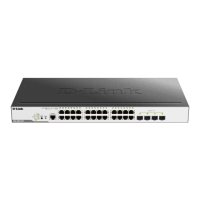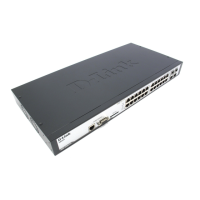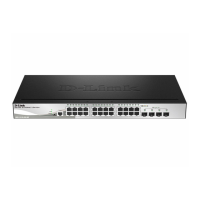
Do you have a question about the D-Link DGS-1510/ME Series and is the answer not in the manual?
| Product Series | DGS-1510/ME Series |
|---|---|
| Managed | Yes |
| MAC Address Table | 16K |
| Power over Ethernet (PoE) | No |
| Device Type | Network Switch |
| Primary Function | Network switching |
| Port Type | 10/100/1000BASE-T, 10G SFP+ |
| Layer | Layer 2/3 |
| L2 Features | STP, RSTP, MSTP, LACP, IGMP Snooping |
| L3 Features | Static Routing |
| Quality of Service (QoS) | DSCP |
| Security Features | ACL, Port Security, DHCP Snooping |
| Management | Web GUI, CLI, SNMP, RMON |
| Power Supply | Internal |
| Operating Temperature | 0°C to 50°C (32°F to 122°F) |
| Storage Temperature | -40°C to 70°C (-40°F to 158°F) |
Details on connecting to the switch via its serial port using terminal emulation and the default serial port settings.
Procedure for assigning an IP address to the switch for management and communication purposes.
Displays a list of currently logged-in users on the switch, including their live time and source information.
Configures the serial port's bit rate and auto-logout time for management host communication.
Command to create a new VLAN on the switch, specifying VLAN name, ID, and type.
Configures a VLAN by adding, deleting, or managing ports and GVRP state for the specified VLAN name.
Enables the 802.1X function on the switch, controlling port access based on authentication.
Creates user accounts with specified roles (admin, operator, power_user, user) and encryption settings.
Configures IP interface settings, including IP address, VLAN, state, BOOTP, DHCP, and IPv6/IPv4 parameters.
Displays the current, modified, effective, or boot-up configuration, with filtering options.
Manages software error logs: dump, clear, or upload to a TFTP server.
Configures DHCP relay features, including hops, time, and option settings.
Configures DDM log and trap actions for exceeding alarm or warning thresholds on ports.
Configures prevention state and action for various DoS attack types.
Enables or disables the Energy Efficient Ethernet (EEE) function on specified ports.
Enables the global ERPS function, activating the specified ring when global and ring states are enabled.
Configures the switch to deny NetBIOS packets on specific ports.
Creates a static unicast MAC address entry in the forwarding table.
Configures IGMP snooping globally or per VLAN, including state, fast leave, and report suppression.
Creates a static IP-MAC binding entry, specifying IP address, MAC address, and optional ports.
Enables DHCP snooping mode, allowing the switch to learn IP addresses via server ports.
Creates a link aggregation group with a specified ID and type (LACP or static).
Globally enables the LLDP function, allowing the switch to transmit and receive LLDP packets.
Configures per-port LLDP advertisement options, including notifications and management addresses.
Sets up the loop-back detection function for the entire switch, including timers and modes.
Enables MAC-based Access Control globally on the switch.
Configures port-specific settings for MAC-based Access Control, including state, mode, and user limits.
Enables the Spanning Tree Protocol (STP) globally on the switch.
Configures global STP bridge parameters such as max age, hello time, and forward delay.
Displays statistics about packets sent and received by the switch, broken down by frame size/type.
Shows real-time CPU or port utilization statistics, including TX/RX rates and usage.
Sets the system-wide maximum number of MAC addresses that can be learned for port security.
Configures system-wise PoE parameters, including power limit and disconnection methods.
Configures port bandwidth limit control for transmit (TX) and receive (RX) rates.
Maps the 802.1p user priority of incoming packets to hardware queues for traffic prioritization.
Adds a new RADIUS server configuration, including IP address, key, and port settings.
Displays authenticator statistics information for specified ports.
Configures the SSH service encryption and data integrity algorithms.
Configures general SSH server parameters like max sessions, timeouts, and TCP port.
Enables SSL status and cipher suites, potentially disabling Web access.
Configures the SSL cache timeout value for removing expired session IDs from the web server.
Enables the SMTP status on the switch.
Creates an SNMP community string to define access permissions for SNMP managers.
Enables the SNMP function on the switch.
Enables the single IP management function on the switch.
Configures the role state and parameters of the discovery protocol on the switch.
Clears the switch's history log entries.
Displays the switch's history log, with options to filter by index, severity, or module.
Downloads firmware or configuration files from TFTP/FTP servers to the device.
Configures SNTP primary, secondary, and poll interval settings.
Configures broadcast, multicast, and unicast storm control, including action and thresholds.
Creates a trusted host entry, specifying IP addresses allowed for management access.
Enables the VLAN trunk function, allowing trunk ports to forward all tagged frames.
Enables the password recovery mode for resetting forgotten passwords on the switch.

